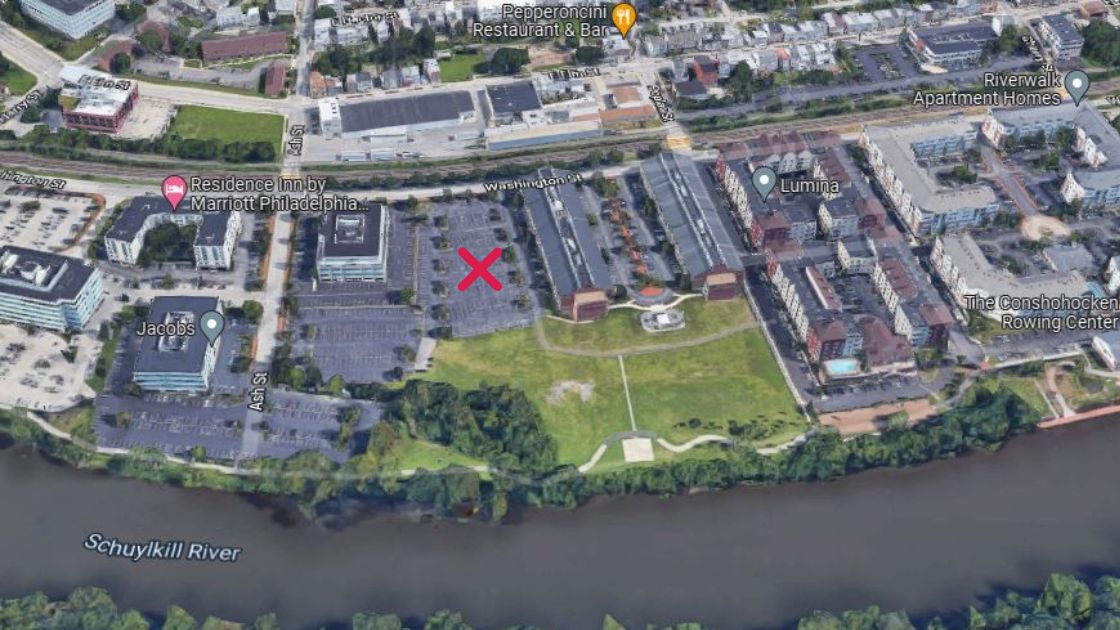During its December 19th meeting, the Conshohocken Zoning Hearing Board unanimously voted against the Borough of Conshohocken’s motion to quash an appeal by a developer who is seeking to build an apartment community along the riverfront in the borough. The apartment building would be four stories and consist of 79 units.
The appeal from the developer involves a letter written in response to its submission of a land development plan for a parcel between 20 Ash Street and 225 Washington Street that is currently utilized as a parking lot. The property falls within the SP-2 (Specialty Planned) zoning district. The developer is Millennium Waterfront Associates II, LP, which is associated with Brian O’Neill who previously developed two apartment communities along the riverfront within the same zoning district (Riverwalk and Lumina, which was previously known as Londonbury).
The letter in question was penned by the executive assistant to the borough manager. In the letter, it was stated that the application was rejected due to residential uses not being permitted within SP-2.
The developer’s attorney, Edmund Campbell, argued that the letter constituted a zoning determination, which his client has the right to appeal to the zoning hearing board. The borough’s attorney, Michael Peters, argued that since the letter was not from the borough’s zoning officer, but from an administrative employee, it was not a zoning determination and thus outside the purview of the zoning hearing board.
With the zoning hearing board agreeing with the developer, the developer can now appeal the zoning determination (that residential uses aren’t permitted within SP-2) made in the response letter. This hearing will take place in early 2023.
When the land development plan for this proposed apartment community was submitted by the developer on March 8, 2022, the developer believed it to be a by-right plan, meaning that how it planned to develop the property met the requirements of the zoning code.
As mentioned above, the borough stated within the response letter that residential uses were not permitted within SP-2. During this same time period, the borough council was considering removing residential uses from the four specialty-planned districts that constitute the entire riverfront, the areas below East and West Elm streets, and SORA West (the area that is now home to the hotel, office building, parking garage, and square).
Upon review, borough documents from 2022 do not differentiate SP-2 from the other specialty planned districts (SP-1, SP-3, and SP-4) pertaining to the removal of residential uses. For example, from minutes of the February 2, 2022 meeting of the borough council:
Mr. Peters shared that Borough Administration has performed a comprehensive review of its housing stock and, at the same time, has performed a comprehensive analysis of emergency management within the Borough, specifically within the area of the Borough located on or near the Schuylkill River. He explained that based on that analysis, Borough Administration recommends that Council consider amending the SP-1, SP-2, SP-3, and SP-4 zoning districts to remove residential uses as permitted uses in any of the specially planned districts.
The same language is then used in April 2022 when the borough council voted to take action on an ordinance to remove the residential uses. From the April 20, 2022 minutes:
Mr. Peters reviewed the proposed ordinance amendment which would remove residential uses from the Specially Planned Districts: SP-1, SP-2, SP-3 and SP-4 Districts.
It is important to note that the 2022 letter from the borough to the developer was prior to the zoning code being amended to remove the uses and was refering to the then current code.
So were residential uses allowed in SP-2 prior to the April 20, 2022 vote?
The zoning code for the SP-1 and SP-2 districts had previously been amended in August 2013, however, based on the actions of the borough it doesn’t appear residential uses were removed at that time. For example, the borough council voted in 2022 to remove residential uses in SP-2 (which wouldn’t be needed if they didn’t exist).
Second, after the August 2013 zoning amendment, the borough council considered three conditional uses involving a proposal to build apartments at 401-433 Washington Street (in SP-2) that had been submitted by O’Neil. There were also zoning hearings involving this project. The conditional uses and the variances did not involve the “use” (the right to build an apartment building), but issues like stormwater facilities, setbacks and open space.
If residential uses weren’t permitted within SP-2 in late 2013 the developer would have had to seek an amendment to the zoning code or a zoning variance to allow apartments. The fact that this wasn’t required, and the borough and zoning hearing board held hearings on the project, shows that the position of the borough at the time was that residential uses were allowed.
More to come.

